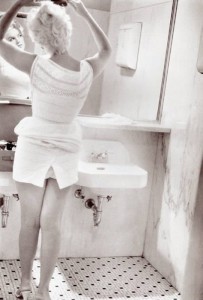
The Sad: The incredible photographer Eve Arnold has passed away.
The Ugly: Losing Ground on Women’s Rights: In 2011, Sex Ed, Contraception, Abortion Rights All Under Seige.
Calls to activism, social vision.

The Sad: The incredible photographer Eve Arnold has passed away.
The Ugly: Losing Ground on Women’s Rights: In 2011, Sex Ed, Contraception, Abortion Rights All Under Seige.
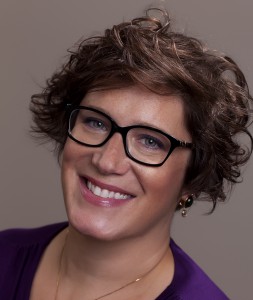
Continuing my talk with Ali Cudby, author of Busted! The FabFoundations Guide To Bras That Fit, Flatter and Feel Fantastic. (Enter to win a signed copy of the book here!)
As a researcher *, I disagree that corsets were as restrictive as the roles women had in society. Because women controlled how tight they laced, could remove stays, etc., there was far more control by the individual over her corset than her culture. Culture has been far more damaging, suffocating, than any corset.
There were actually significant health issues directly tied to corsetry, as well, particularly when the fashions dictated the smallest possible waist. Women did permanent damage to their lungs and even rearranged their internal organs to accommodate corsets! Plus, it was (in my oh-so humble opinion) a lovely turn of phrase…and I love a good turn of phrase. :)
In that sense, women today who are not wearing a properly fitting comfortable bra are doing far worse things to themselves and their bodies than corsets, really. We are imprisoned by the places and times we live in, yes, but our ignorance of our bodies, our bras, is some sort of self-inflicted madness at this point…
Agreed, especially as society is less rigid today and women have much more opportunity to make decisions for themselves about how to dress, especially underneath their clothes.
To that extent, I see your book as a companion piece to the iconic Our Bodies, Ourselves. How can we be the action figures we need to be in our lives without knowing this fundamental functional part of our lives? That question may be rhetorical… (Feel free to comment though!)
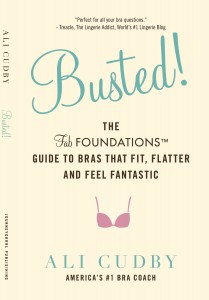
Naturally, I love the idea of being a companion piece to the seminal Our Bodies, Ourselves! When it comes to bras, specifically, the thing I love is how empowered women feel when they figure out how fit works on their bodies. It’s fantastic to help a woman feel better in her skin and move past the negative body image messages perpetrated by the media.
I’m glad you mentioned body image messages in the media… Fundamentally, we women think we know our breasts. But we really don’t. I think we more about how our breasts are “supposed” to appear, clothed or not, and we certainly have feelings about that… But we really don’t know our own breasts, do we? How does this compound the matter of fit?
I don’t think I’ve said that women don’t know their own breasts, but women certainly get mixed messages about the role of breasts in society.
No, you didn’t say that bit about women not knowing our own breasts; I did. *wink* It seems we don’t know as much as we should, or we wouldn’t suffer with bras that don’t fit!
If you’ve never been taught how a bra should fit, and you may not even be aware of brands that are designed for your specific body type, it’s like trying to hit a moving target with a blindfold on!
In Chapter Two, in Once Upon A Time, When Fit Was A Fairy Tale, you discuss the fairy tale of fit:
Bra fitting can be confusing because there are so many pieces to literally fit together, and it’s not something most American women are taught — not at home, in school, or anywhere else. There’s no real mechanism for that education. It’s not taught in high school health classes. Many mothers overlook the chance to help their daughters get fit correctly, perhaps because they never experienced the benefits of the right fit themselves.
So poor bra fit is literally passed down through the generations!
Historically, speaking, what’s to blame for this? How much of women’s ignorance to the issues of bra fit are our fault? How much do we, must we, hold others accountable for? How do we take back our breasts, our health, our lives? Is there anything we can do at the consumer level?
I think economics and the bottom-line thinking that has been so pervasive in America is the culprit. Customer service has left the building in a lot of areas of the department store (except the men’s suit department…hmmm).
The good news is that I see a swing of the pendulum in the opposite direction. There are an increasing number of fit-based boutiques out there. Right now, most of them cater to the high end of the market, but it could be a beginning of a movement. I’d like to think so, at least! The product is there, the message is getting out…so I’m optimistic about the direction this industry is going.
We’ve all heard (and quite possibly ignored) the percentages of women who are not wearing a properly fitting bra; what does this percentage mean in terms of number of women?
The numbers are staggering. Between 80-100 million American women spend several billion dollars each year on bras that don’t fit and cause them physical and emotional harm!
And that’s just women over the age of 18 — the youngest group of women are actually most likely to wear bras that don’t fit.
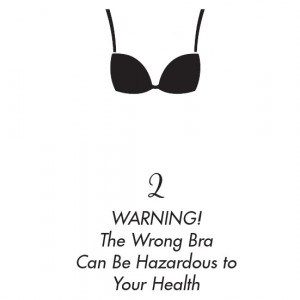
I know you’re not a doctor; and neither am I, but I’d guess this phenomenon of poor fitting bras and the increase of medications for depression, anxiety, aches and pains, lethargy, et al. is likely related. My readers might think I exaggerate — do you have any comments on the links between poor fitting bras and the things that ail us?
I know that women who have gotten fitted report that they no longer have daily headaches, shoulder aches and back pain. They stand taller and feel better — both physically and emotionally. I know that was true for me, and my experience is what led to me writing this book.
To say that proper bra fit can be life-changing may sound overblown to some, but I’ve seen it happen way too many times to question the phenomenon!
The reason I find your work, your book, so amazing is that women spend how many hours a day in their bras? I mean, even if we take them off the second we can, it’s a lot of hours to be miserable! Like that seminal feminist work, Busted! is based on the principal that we can be instruments of change — for ourselves, personally, and for society itself. In order to do that, we need to be educated. Did you have any idea when you began your work as a bra coach that you’d be writing such a book? Did the connections between bras and health, society, etc. surprise you?
First off, thanks! I really appreciate it. My work has evolved very organically. It started with my own moment of realization, when I found pretty bras that fit and were comfortable. I started talking to my friends about my discoveries and began helping them. Then friends started bringing friends, and the seeds of my fit methodology began to gel, and I started talking to industry experts and blogging about my experiences. The more I learned, the more I realized how pervasive this issue is, both from a comfort standpoint and also that connection to self-image so many women face.
Bra coaching goes way beyond bras — it goes to the core of how we carry ourselves as women. I didn’t expect that, and every time I hear back from someone who has benefitted from my fit methodology, it’s incredibly fulfilling. Helping women feel better about themselves is rewarding on so many levels.
Is this an American problem; are things better in the UK or elsewhere?
Culturally, women from the European countries seem to value buying fewer items of better quality more than in the US. And in the UK there is a wider array of product available in more places, it’s just easier to find stores that carry a variety of sizes. But availability of product doesn’t necessarily translate into excellence of fit. Fit is a challenge worldwide, simply because there are so few standards for sizing within the industry.
I would love to see American women placing more value on finding a quality garment that fits, versus going for the least expensive, or only buying on promotion.
Since you work with bra designers and other in the manufacturing industry I have to ask, how much of the problems regarding limited bra sizes begin there? Or is it the retailers who are the biggest problem?
I think there’s a ton of great product out there in a huge range of sizes – like I’ve said, 28AAA through 56N. The challenge is finding what works for you.
There are real issues for retailers when it comes to stocking that wide range of products, the amount of inventory required is mind-boggling. So (as with most things in life) it’s more complicated than it seems and I honestly believe that most manufacturers and retailers want their customers to be thrilled with their purchases.
Rather than focus on the inherent problems, I see a great opportunity for women — own the solution by understanding fit on your own body and finding the products that work for you, either in local stores or online. It’s very empowering!
Now go forth, ladies, empower yourselves with Busted!
Further reading: Another interview with Ali Cudby at A Slip Of A Girl.
* In fairness to Ali, and for clarification for you readers, I should note the following. Ali and I had a bit more of a discussion about corsets and history. She is operating off the more generally accepted wisdom about corsets, yet when I proffered her my research (What If Everything You Knew About The Corset Was Wrong?, Corsets Are Too Sexy?, Corsets Bound To Stay Suffrage), she not only read the posts but called them “fascinating!” We happily agreed to the following: Corsets, while restrictive, may not have been AS restrictive as women’s roles in society. That is probably more than a humble research obsessed feminist historical blogger can really ask for.
Few things excite me this much. Few contemporary things, that is. But I’m all giddy about a book that’s just been released: Busted! The FabFoundations Guide To Bras That Fit, Flatter and Feel Fantastic by Ali Cudby.
Ali Cudby is American’s #1 Bra Coach, the founder of Fab Foundations™ — and one hell of a great woman with a mission I adore. I was introduced to her by my friend and lingerie blogger, A Slip Of A Girl — who is, by the way, currently running a contest where you can win one of five copies of the book signed by the author. Go ahead; go enter the contest now. I’ll wait.
When Slip told me there was a book which could actually assist me in finding a bra — or even several bras! — which would fit while looking good and feeling super, I was skeptical. It seemed like the cosmetic ad promises: hope in a jar; hope between the covers. But quickly I found that Cudby’s book was more than hope and promises — it was a plan that works!
It was then that I became smitten with Ali Cudby, starting a dialog which was so long and insightful, that I’m breaking up the interview into two parts. We begin with the personal…
Ali, your story, like mine, begins with the problems of big busted women — but that’s not the only women who have difficulty. Were you surprised — horrified? — that smaller-busted women also suffered from the insanity?
In the very beginning, I started with the idea of covering only full-busted women in the book – it never occurred to me that petite women had similar issues. I was shocked when I started hearing the stories from smaller-busted women. We all deserve to feel beautiful, and when you’re told to shop in the children’s department, or told you don’t even need a bra, it makes petite women feel like they don’t even count among the ranks of women. That’s a huge barrier to feeling feminine, so it makes sense that this book is for everybody…and every body!
There are 16 questions in the Personal Assessment at the end of Chapter One — I’m too embarrassed to admit how many of them I had the positive-sounding, but negative-in-reality, response of “Yes.” (In fact, I found myself starting with an emotional “Yes! She gets me — this must be common!” but after so many, my ego deflated…) How many of the 16 problem symptoms do you think the average woman has?
Great question! The intent of the Personal Assessment is certainly not to make your ego deflate — sorry! — but hopefully to help you realize that all of these issues will be addressed in the book. They are common!
I would say that the majority of women I fit (if they’re being honest) would be answering “yes” to at least 10 of the 16 questions, and oftentimes more like 13-14. The idea of the Personal Assessment in the beginning is to make it clear that there’s an issue (guess I did that!) and have the book guide you through turning all of those issues around by the final FabFit Assessment at the end of the book.
Obviously, the best way for a woman to get a bra that really fits, is to go into a store and try them on. But what about the times where literally, you cannot find a store with bras larger than 38DD — and those are, in fact, too small? (Yes, this is personal experience! Every clerk I asked about the possibility of bras in larger sizes, of hidden stock consisting of the less-flattering-on-display bra sizes, was shocked — as if I belonged in a circus!)
Are we really forced to order a bunch of guessed sizes in several bra styles and brands, have them shipped to us? I mean even if these places have easy return/exchange policies, this wreaks havoc with a lady’s finances! How do we at least narrow down such a big search so that we have less up front (so to speak!) investment in bras?
Hearing your story makes my blood boil! Too many women are made to feel like THEY are the problem and it’s absolutely NOT TRUE! The good news is that there are great (and gorgeous) bras out there, in a variety of price points and in sizes that range from 28AAA all the way to 56N!
In the book, I go through specific steps to help make Internet shopping work for you. That should cut down on both the confusion and the outlay of cash.
I also have a secret website only for people who buy the book, and not only is there great information on the site, but there are exclusive coupons as well. And I’m in conversation for contests and other goodies for the page. Heck, the book practically pays for itself! :)
In your book, you talk about the prices of bras. While you are clear to say that you don’t have to buy the most expensive bras, there is some truth in getting what you pay for as well… What’s a respectable, reasonable, price to pay for a decent bra? What’s the average lifespan of any bra? A properly fitting bra?
I think there’s a balancing act when it comes to price. Some of the most expensive bras out there are pieces of art, but not designed with fit in mind. Then there are very expensive bras that are absolutely amazing for fit, and are made from the finest materials, have incredible hand-stitched embroidery, lace, etc. You absolutely get what you pay for! But do you need to spend that kind of coin to get a bra that will fit properly? No, you don’t.
You are asking a bra to do a job, and for some of us, it’s a big job. You want a quality bra that will last without stretching out or falling apart.
Unfortunately, you can’t depend on price as a good indicator of quality, and that’s why I break down the quality indicators of a bra in the book — from construction to embellishments — to help you get the most bang for your buck.
How you take care of your bras will also have a HUGE impact on how long they last. There are a lot of numbers thrown around the industry for the lifespan of a bra, but I say it should last around 6 months of wearings, or until it’s no longer doing the job of supporting your bust.
[Breaking down the price of “expensive” to the ridiculous… Ladies, if you buy a $70 bra, that’s like $11 a month. If you even wear that bra 10 times, that’s just over a dollar a day. Remember those old “less than the cost of a cup of coffee” commercials, designed to make you weak with the need to help a stranger? Why aren’t you moved to help yourself first? Tsk Tsk Tsk Charity begins at home! In this economy, can you afford to waste money on disposable cheap bras each month?]
Aside from the obvious changes in our bodies, such as weight changes, pregnancy, etc., how often should a woman go through the bra assessment? What are the average number of times a woman’s body changes enough to warrant a bra check?
You should reassess your fit every six months, plus any time your body undergoes a weight fluctuation of 5 or more pounds. Let’s say you get this book when you’re 20. If you use the information you learn to buy bras, you’re looking at 50+ years of bra purchasing. That’s around 100 times that you need to reassess your fit. And you need more than one bra, so figure you have at least 3-5 bras at any one time (the barest of minimums, including sports bras.) That’s a lot of bras over a lifetime! I think every woman deserves to look and feel amazing, and shouldn’t waste money on bras that don’t work for her body. (How many ill-fitting bras are collecting dust in your lingerie drawer?)
You know the old adage that you give someone fish and they eat for a day, or you teach someone to fish and they eat for a lifetime? Well, this book is all about teaching women to fish, so to speak. :) That’s why I call myself a bra coach – because I want all women to learn how to understand fit for their unique bodies, for the rest of their lives.
[That means, ladies, that Busted! is a book that pays for itself — and quickly. That’s even before you get to the secret goodies stashed on Ali’s site. Get this book before you even get the aforementioned quality bra and that bra will fit!]
This interview is “To Be Continued” — meanwhile, get yourself a copy of the book. Order it; enter to win it. Then come back tomorrow for the rest!
In light of the recently released Congressional Budget Office report on income inequality, I found this cover of the August 1969 issue of Fortune relevant — especially the The Time Bomb On Wall Street feature. Of course, to know how relevant it really is, I’d need a reading copy of the vintage magazine…
PS OK, so maybe I’m stretching the Signs Of The Times dealio to include magazine covers, but it’s my blog; feel free to complain in the comments.
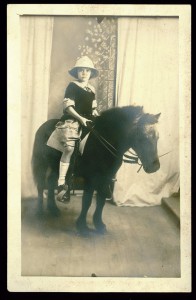
Come explore with me!
Beware Pinkwashing at The Girlie Girl Army: All about how unhealthy and manipulative buying “pink” for breast cancer awareness &/or research can be.
At Sociological Images, Google Index of Poor Mothers’ Pain: Using Google to research what poor women with children really live like, what they are in search of, what they need. (See also: Why We Vilify Single Moms.)
Sex Tips For Husbands and Wives from 1894 at Writing Women’s History: A hoot, once you get past the notions of the past that haunt us still today.
Image via Lynnstudios.
Making Democracy Work & Grow: Practical Suggestions For Students, Teachers, Administrators, and Other Community Leaders, from the Federal Security Agency, Office of Education, Bulletin 1948 No 10, Oscar R. Ewing, Administrator, John W. Studebaker, Commissioner.
A more subtle Cold War publication, preaching that we must do more than “learn the values & working habits of democracy,” we must “live it” to “strengthen national security and to win the peace.” “We must also work together — to keep democracy free and make it strong and positive.” On the last page, advice on “cooperating” with the Motion Picture Council to “encourage the showing and reshowing of movies that stimulate an understanding and appreciation of American democracy” in your own community. Other media is included in this vintage propaganda booklet; but the film section rather covers it all — the seemingly benign advocacy setting darker things in motion…
Last week I watched The Republican Debate at the Reagan Library. I found myself astounded by the fact that these people with limited intellectual reasoning, if not limited intellectual functioning, were in positions to actually be running for President of the United States of America. I’ve more to say on that subject (expect another post soon), but for now, I’m just going to focus on the one subject in which I found myself even more shocked: the one time when I found myself agreeing with some of the things the potential candidates said.
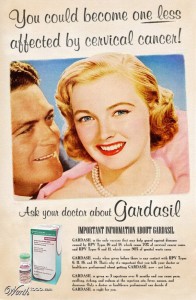
The subject was mandatory use of the Gardasil HPV vaccine; something I’ve long considered dangerous — especially as it’s equated with crony capitalism. Now, to be clear, I’m not one of those who thinks that preventing a disease which is linked to sexual behavior is akin to giving young women (or anyone) a Go Out & Screw card; you should know by now I’m not that kind of silly. But I’ve been concerned for a long time about the dangers of Gardasil, a drug pushed through quickly and forced upon young women and their families who are kept ignorant of the dangers — including deaths — of the vaccine. However, as I was soon to be traveling, I decided I didn’t have time to write about this subject again. Until…
Not long after I arrived home last night, my father in law called me. A reporter, Kristin Helgeson from Valley News Live, had left a message for him, asking if he was related to a Deanna Dahlsad. Yes, he is; yes, I called the phone number Helgeson left, and left her a message. But it wasn’t until this morning that the reporter and I connected.
Seems Michelle Bachmann stepped in it again, this time taking one individual and unverified comment and making the claim that “Gardasil led to mental retardation,” and Helgeson, having found my coverage of Gardasil at my other blog, wanted a comment from me. However, now that it was the next day, the story is “over.” While Helgeson was interested in pursuing the information I had, her boss, News Director Griff Potter, felt new and more accurate information wasn’t warranted — at least not enough to continue the story on air. Instead, Potter feels that I should just add a comment to the news story on their website.
It’s here that my story turns, for the moment, from one of the dangers the Gardasil vaccine, to that of the problems of The Media.”
In Valley News Live‘s coverage of the story, they reported:
On their website, the Center for Disease Control (CDC) has a review page for this vaccine. None of the serious side effects have been linked to the vaccine and there have been no reports of mental disability. In fact, the most serious side effect they found was fainting. They now ask patients to sit down for 15 minutes after they get vaccinated.
This may be true — but it’s clearly not the whole story! As I’ve uncovered, there are deaths linked to Gardasil — in the US and India. While Valley News Live may not find their omission “retraction worthy,” surely they should present the other information that the public ought to be informed about. And they should do so in the same format as their original coverage. One hopes that the folks at Valley News Live know that their television viewers are not necessarily those who will turn to the Internet and look for updates on earlier stories (or trust the comments left by some “kook” like me); if there was something important to add to the story, they’d show it on the news right? Wrong.
I want to be clear here and state that Helgeson wanted/wants to proceed with the story. And I did call Mr. Potter to voice my concerns too; as of this writing, he has not returned my call. I hope he is out to lunch in the literal sense, not metaphorically, and that I will hear from him — or from Helgeson, saying Potter has reconsidered. But until then, this whole thing just makes me so angry.
How long will the arbitrators of news continue to dismiss the issues in this story? How long will they continue to discount women — not just as part of their audience, but in general? For cutting or ignoring the facts from stories like this only perpetuates the problems of poor ethics in everything from medicine and politics.
For more, see my other related posts, at varying sites:
Is Medicine At Odds With Women’s Health?
Controlling Parts Is Controlling The Sum Of Its Parts
What If Everything You Knew About The Corset Was Wrong?
And do see my Gardasil coverage.
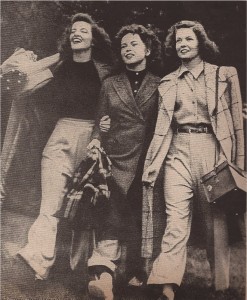
Let’s walk — and read — shoulder to shoulder, my sisters…
The first two posts that rather address a backwards feminism post at HuffPo: One at BUST and the other at A Slip Of A Girl. Why should I add anything when they’ve both done so well?
At Silent Porn Star (yup, that means this next link is NSFW), my fellow “nutty Egyptologist” pal discusses brotherly and sisterly love — in terms of etymology, fictive kinship, marriage of kin, and DNA evidence — in ancient Egypt. Interesting food for thought for this armchair anthropologist.
In No Sex, Please, We’re Literary!, author Karen Essex discusses the double-standard which goes past the roles and experiences of the characters, to the limitations of the authors. Here’s a quick snippet; but please go read the rest.
The point of my books is to give voice to otherwise voiceless females from history and myth; to unlock what has been secreted away in women’s hearts and minds for thousands of years; to express what has been unutterable. Historically, women have either been reduced to nothing but their sexuality, or stripped of it entirely; the Madonna or the whore. Are those two options not more degrading to a female character than allowing her the full range of human experience?
Karen Essex has also just earned a permanent link on the blogroll for that post; but she’s an achiever. You should also read Women: Is it our own fault? — which is in response to her earlier post, Take Back The Tit, which also rather addresses the icky HuffPo post too. See? Now we’ve come full circle!
Image credits: Katharine, Marion and Peg Hepburn photo taken by Martin Munkacsi, August 1939, via.
I absolutely adore this piece by Jeanann Verlee:
Unsolicited Advice To Adolescent Girls With Crooked Teeth And Pink Hair
When your mother hits you, do not strike back. When the boys call asking your cup size, say A, hang up. When he says you gave him blue balls, say
you’re welcome. When a girl with thick black curls who smells like bubble gum stops you in a stairwell to ask if you’re a boy, explain that you keep
your hair short so she won’t have anything to grab when you head-butt her. Then head-butt her. When a guidance counselor teases you for handed-down
jeans, do not turn red. When you have sex for the second time and there is no condom, do not convince yourself that screwing between layers of underwear will soak up the semen. When your geometry teacher posts a banner reading: “Learn math or go home and learn how to be a Momma,” do not take your first feminist stand by leaving the classroom. When the boy you have a crush on is sent to detention, go home. When your mother hits you, do not strike back. When the boy with the blue mohawk swallows your heart and opens his wrists, hide the knives, bleach the bathtub, pour out the vodka. Every time. When the skinhead girls jump you in a bathroom stall, swing, curse, kick, do not turn red. When a boy you think you love delivers the first black eye, use a screw driver, a beer bottle, your two good hands. When your father locks the door, break the window. When a college professor writes you poetry and whispers about your tight little ass, do not take it as a compliment, do not wait, call the Dean, call his wife. When a boy with good manners and a thirst for Budweiser proposes, say no. When your mother hits you, do not strike back. When the boys tell you how good you smell, do not doubt them, do not turn red. When your brother tells you he is gay, pretend you already know. When the girl on the subway curses you because your tee shirt reads: “I fucked your boyfriend,” assure her that it is not true. When your dog pees the rug, kiss her, apologize for being late. When he refuses to stay the night because you live in Jersey City, do not move. When he refuses to stay the night because you live in Harlem, do not move. When he refuses to stay the night because your air conditioner is broken, leave him. When he refuses to keep a toothbrush at your apartment, leave him. When you find the toothbrush you keep at his apartment hidden in the closet, leave him. Do not regret this. Do not turn red. When your mother hits you, do not strike back.
Via PANK Magazine.
Image via.
Cherie Currie and Joan Jett, back in the days when they were Runaways.
I don’t ever claim to be first with the reviews (I deal in old stuff, so why even rush to hop on the bandwagon with films about retro bands?), so you’ve likely already heard about, read reviews of, or even seen 2010’s The Runaways, starring Kristen Stewart and Dakota Fanning. Anyway…
The Runaways is an incredible film. You should see it. My only real comments are really about my impressions of myself…
I wasn’t actually going to write any sort of a review, but then I stumbled onto Susie Bright’s commentary:
“What is this Little Debbie BULLSHIT?” I said. “This is a disgrace.”
Director Floria Sigismondi’s “pretty-in-glam” Runaways promo wasn’t the underground punk scene I remember from Los Angeles in the 1970’s.
And then I thought, “Hey, someone needs to speak for the rest of the un-cool kids here in the Midwest.”
You see, I didn’t know of The Runaways until after there was Joan Jett and the Blackhearts’ I Love Rock and Roll. That made it on the radar — and radio waves — in Midwest suburbia. Heck, my mom was a HUGE fan of that song! (Rock on, Mom!)
Before Bright’s commentary, I’d viewed the relationship between Jett and Currie as a more complicated version of the college lesbianism experience, mixed with drugs, celebrity-too-soon, and, sure, what looked in the film like a bit of opportunistic, if not predatory, moves on Jett’s part — which seemed more natural and less creepy than it sounds, really. And I don’t suppose Bright’s commentary really changes any of that. ( Or that my interpretation of the film is accurate; or even that the film was entirely explicit about many intimate aspects of their personal lives. It was, after all, a film; not a documentary.) But I feel it’s worth noting that Los Angeles is, and was, a million miles away from my Milwaukee suburban experience. Or even my imagining.
I was in gay bars in the 80’s. However, I’m sure they weren’t anything like the punk scenes you big coastal cities had. I’m sure even the leather and dungeon rooms would have seemed comical (at least by comparison at the time). But my point is that even though I wasn’t phobic, wasn’t ignorant, and therefore wasn’t shocked or put-off by anything in The Runaways that would have freaked my version of the world at that time, the sort of cultural context Bright feels was a necessary part of the story has me thinking… Maybe too much.
Yes, it may be accurate to say, as Bright does, that, “The Runaways band would not have happened, could not have been conceived, without the Underground Dyke Punk Groupie Slut culture that stretched from the San Fernando Valley to the bowels of Orange County,” but is it necessary to understand or appreciate the film, the story of (at least two of) the girls in the all-girls band?
Maybe it’s some sort of “ism” for a heterosexual chick to say it doesn’t matter; or at the very least, I’m being insensitive and dismissive to a movement. I certainly don’t mean to be. Yet, I thought the film was about forging ahead against the odds, the isolating experience of individuals — of female individuals — and maybe all that cultural context wasn’t integral? Then again, I’m always harping on the context of things, and certainly the counter-culture is as important in the story of where this band, these women, sat as the cultural norms I was carrying in my own head.
I just can’t decide.
Because fundamentally, I felt the tidal waves of emotion of abuse (self, drug, management, the industry, etc.), dreams gained and lost, friendships, trust, creativity, and being a woman with little respect through it all… And I’m not sure that being more precise in the documentation or depiction of what Bright described as the scene at the time is would have enhanced that ride. Though I guess I’ll never know because that film hasn’t been made.
At the end of The Runaways, I was left wanting to discover what others already had; the music of the band itself. (And the music each made with other bands and in solo careers — save, perhaps, for Lita Ford. Hubby had a crush on her, so her discs are around… Plus, at the end of The Runways, I didn’t like her. Sure, I understood what motivated her snits; but ick.) Though, what Susie Bright said now not only colors my thoughts about the film, but thoughts about the music as well.
Such is the plight of one who thinks too much, I suppose.
Can I continue to rock to Crimson & Clover without having any such thoughts of celebrating a “dyke rock’n’roll legacy” — and not have that be dismissive or exclusionary, not have it be a political or social statement at all? Yes, I think I can. So I think I can enjoy The Runaways as a film without any of that too.
I think that’s the question, and the answer. For me.
I’ll tell you how that works as I listen to more of the music. …Maybe watch the film again.
PS The end of the movie left you rather feeling like Cherie had relegated herself to, or was even happy with, some sort of boring mainstream life after the band split. Clearly the film focused on Jett. (Odd because the movie was based largely on Currie’s autobiography, Neon Angel: A Memoir of a Runaway — originally published in 1989; reprinted to coincide with the film.) But Currie’s life indeed went on. Cherie also went on to play more music; to marry and divorce from Robert Hays (of Airplane! — what an odd pairing in my mind) — they even had a son, Jake Hays, who accompanied his mom and dad at The Runaways premier, and to rock the art as a chainsaw chick.
Just a good old fashioned link round-up — yee-haw!
1.) At The Crunk Feminist Collective, a thought provoking post on self care for the feminist or liberal activist:
Talk about crunk. Bambara gives the side eye to the notion that you can attack capitalism, racism, or other systems of dominance out in the world without challenging those same systems (especially hetero-patriarchy) within one’s own relationships. That, in fact, leaving your own house “out of order” not only jeopardizes but it, in fact, undermines both your potential for good work and your potential for intimacy and happiness. Indeed, for me, Bambara’s call for us to essentially get our ish together charges us to recognize how important—how revolutionary—it is for us to love (and love on) each other and ourselves fiercely and fearlessly.
I started a group for just this sort of thing at Bliss Connect. It’s called Seeking Progressive Social Bliss; so far it’s a circle of one. *sigh*
2.) I was meaning to write about the horrible Summer’s Eve “Hail To The V” Campaign, but then Stephen Colbert did this:
| The Colbert Report | Mon – Thurs 11:30pm / 10:30c | |||
| Vaginal Puppeteering vs. D**k Scrub | ||||
|
||||
I felt nothing could really top that. (Especially as I have a thing for puppets. Really!) However, I highly recommend this post about the hideous ad campaign at Sociological Images. It’s especially good to show those who don’t understand satire; it’s a mental illness, you know.
3.) As I’ve oft complained about the sexualization of children, especially when it comes to clothing (NWS), I found this bit of fashion news across the pond fascinating:
The review, conducted by Reg Bailey, chief executive of the Mothers Union, was published in June. Bailey’s report, ‘Letting Children be Children,’ looked at cultural influences on children and children as consumers but particularly significant for the clothing sector was its examination of clothing, products and services for children.
The report stated that the marketing of “sexualised and gender-stereotyped clothing, products and services” for children were “the biggest areas of concern for parents and many non-commercial organisations contributing to the review.”
[sic]
As the report was published, the British Retail Consortium (BRC) unveiled a set of guidelines governing the design, commissioning and marketing of clothing ranges for children under 12 years old.
The article continues to discuss the practical and impractical issues involved. As citizen of the USA, I’m left wondering if such clothing prohibition is the answer. After all, the problem isn’t the garments glutting the market; it’s the consumers with horrible judgement who pay for clothing in such poor taste. At what point does the law need to protect us from our bad choices? Or, more pointedly, at what point does the government need to protect children from the bad choices of their parents?
Image Credits: Via eBay. (You’d have already seen it if you visited my Tumblr.
Remember the Nirvana song Frances Farmer Will Have Her Revenge On Seattle?
Here’s Kurt Cobain’s response to, “So why was Frances Farmer such an inspiration?” (Melody Maker, August 28th, 1993)
“Well, you know, I’d read some books about her and I found her story interesting. She was a very confrontational person.”
Extremely confrontational.
Selfish, maybe. “That’s not what I got from the books I read. Actually, I did from two of the biographies I read about her, but there was one, ‘Shadowland’, the best one, written by this PI from Seattle who researched it for years, and I didn’t get that impression from that one. She was obviously a difficult person, and got more and more difficult as the years went on, as people started to fuck with her more and more.
“I mean, she was institutionalised numerous times and, in the place in Washington where she ended up, the custodians had people lining up all the way through the halls, waiting to rape her. She’d been beaten up and brutally raped for years, every day. She didn’t even have clothes most of the time.
“Courtney especially could relate to Frances Farmer. I made the comparison between the two. When I was reading the book, I realised that this could very well happen to Courtney if things kept going on. There’s only so much a person can take, you know?
“I’ve been told by doctors and psychiatrists that public humiliation is one of the most extreme and hardest things to heal yourself from. It’s as bad as being brutally raped, or witnessing one of your parents murdered in front of your eyes or something like that. It just goes on and on, it grinds into you and it’s so personal.
“And the Frances Farmer thing was a massive conspiracy involving the bourgeois and powerful people in Seattle, especially this one judge who still lives in Seattle to this day. He led this crusade to so humiliate her that she would go insane. In the beginning, she was hospitalised – totally against her will – and she wasn’t even crazy. She got picked up on a drunk driving charge and got committed you know. It was a very scary time to be confrontational.”
Though nothing could excuse what was done to her, even the most reverent accounts of Farmer’s life don’t attempt to deny that she was on extremely difficult person, that her much-vaunted independence often amounted to a ruthless self-interest that left her indifferent to the suffering she caused. So she was no martyr.
But Farmer – beautiful, arrogant, creative, destructive and destroyed –does appear impossibly glamorous, especially from the safe distance of a few decades.
Is that what drew you to her?
“No. No, not at all”
The song, especially if Geffen have the good sense to release it as a single, may succeed in glamorising her.
How would you feel about that?
“I’d feel bad about that. I just simply wanted to remind people of tragedies like that. It’s very real and it can happen. People can be driven insane, they can be given lobotomies and be committed and be put in jails for no reason. I mean, from being this glamorous, talented, well-respected movie star, she ended up being given a lobotomy and working in a Four Seasons restaurant.
“And she hated the Hollywood scene, too, and was very vocal about it, so those people were involved in the conspiracy, too. I just wanted to remind people that it happened and it has happened forever.”
Most of your songs are, in one way or another, about suffering. A popular liberal notion is that suffering ennobles. Do you think there’s any truth to that?
“It can, it can. I think a small amount of suffering is healthy. It makes your character stronger.”
Do you think you’ve suffered on a large or small scale?
“What do you think I think?”
Don’t know.
“I’ve suffered on a large scale but most of the attacks haven’t been on me, they’ve been on someone I’m totally in love with, my best fucking friend is being completely fucking crucified every two months, if not more. I read a negative article about her every two months.”
Why read it? Why torture yourself?
“A lot of the time I can’t escape it because Courtney gets faxes of articles from the publicist all the time. But also it’s a form of protection. It enables you to remember … and to make sure you never deal with those people again. And another reason we like to read it is that we can learn from the criticism, too. If I never read any of the interviews I did, I’d never be able to say ‘Jeez, that was a pretty stupid thing to say. I’d better try to clear that up.’”
I was first introduced to Frances Farmer — and subsequently fell in love with both her and Jessica Lange — in Frances (1982).
The book Cobain “recommends,” Shadowland, by William Arnold, and the ensuing (no pun intended as Arnold sued regarding the film) Lange movie may not be reliable, according to journalist and researcher Jeffrey Kauffman who has spent decades unraveling the Frances Farmer story. However, this doesn’t change much for me.
It’s not that I refuse to accept fact or Kauffman’s research; quite the contrary. I find all the representations and misrepresentations as detrimental to Farmer as the life she did lead. Mental health, especially then, was not kind, no matter what the ignorant intention. The media has only become worse. Her life as a creative, passionate woman was painful, co-opted.
Message in Washington, D.C., July 28, 1922; message to Washington, D.C. today.
Don’t let the tea party-ers or republicans fool you: the hold-up on the debt ceiling has nothing to do with balancing the budget or creating smaller, less intrusive government. Despite running on such slogans, or “jobs,” those who were swept into office also swept in their own dirty under-the-rug ideologue agendas. Look at restrictions on abortion, for example. Fear, misogyny and racism rule; using legislation to create more government intrusion to benefit wealthy white men. Meanwhile, these elected conservative officials pass on the lies and deny the reality of the Bush tax cuts which, by the way, blew-through Clinton’s surplus and, along with deregulation and cronyism, created this mess.
Other shades and shadows from the 1920s which are today’s boogeymen:
Photo via Library Of Congress.
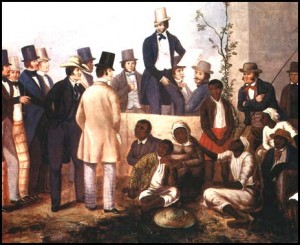
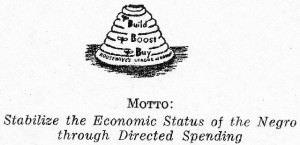
“Think Global, Act Local” is more than an old saying or mantra; it’s a philosophy. Thinking globally while acting locally is a way to take huge problems, like racism (as the image shows), and break them down into manageable, individual, acts. It motivates anyone who believes “If you’re not part of the solution, you’re part of the problem.”
I was reminded of this when Nazneen Hamilton wrote about the importance of buying locally produced items. It’s not only a wise thing to help your local economy — and generally helps your own household finances (something you know I care about) — but it also has a huge impact on the environment.
Heck, buying locally grown food and/or locally made products is a far greener thing to do than getting a newer less-gasoline-guzzling car or even getting one of those hybrid or electric cars — because the cars and batteries are brought over the oceans on freighters, freighters which leave far larger carbon footprints (or wakes) than most of us can imagine.
So I have to ask you, when’s the last time you checked the labels to see if you could buy local?
And, if you do and find your favorite shop doesn’t offer a local alternative, have you pushed them to do so?
On the front of this 5 3/4 X 3 1/2 “snapshot,” which the seller says is circa 1915, someone has printed “AN ARIZONA SUFFRAGETTE.”
As I cannot handle this photograph, I am not certain of it’s age — but I am certain that the “suffragette” it is a man wearing a dress and apron. Something about the photo feels more modern than 1915… Maybe it’s just that men putting on dresses to mock women for being too masculine to be pretty, that equal rights for women is as silly as a man wearing a dress, that the whole thing is just too-too familiar.
In The Washington Post, November 1, 1909, an unidentified “London fashion designer” gets bitchy and judgmental about how suffragettes dress. Yes, even though I don’t know if this possibly fictitious designer is male or female, I say “bitchy.” For even should ye olde fashion designer be both real and male (gay stereotypes aside), the fact that this item appeared at all in the Society pages, is proof of the bitch factor.
But perhaps most importantly are the number of appearances of myths, stereotypes, and general mean spiritedness which are preyed and played upon today:
The worst blow the cause of equal suffrage has received is the charge that its champions are careless in dress. Women who are not neat in attire and care nothing for personal adornment cannot hope to attract or influence men, and the future is gloomy for the British suffragettes at least. A London fashion designer has divided the suffragettes into four classes, each one marked by distinctiveness in dress.
“In the first is the woman of independent means,” says this fashion critic, “who can can and following her habit does dress well, and also the woman of limited income with an instinct for clothes Secondly, there is the working suffragette, who, as a rule, is a typewriter, and goes to the office in neat shirt waist and skirt She does not differ in any way from the woman clerk in any ordinary office, or the school teacher and secretary Thirdly we arrive at the thin, corsetless esthetic type, the modern development of the love-sick maiden who adorned Bunthorne These ‘willowy’ suffragettes adopt the empire and pinafore gown, with strange embroideries and sometimes strange results Last of all comes the suffragette who looks as though she had just returned from the wars and was still in fighting kit She generally wears a green costume of skimp design and rough material, a purple scarf, an impossible complexion, ‘something’ on her head and ‘something’ on her feet Few suffragettes have the faintest idea how to dress their hair Either they have not the time to spare from work for the great cause to give their hair ordinary care or attention, or else the languid drooping style and the straying wisps of hair are meant to illustrate the down-trodden station of women”
All of which should make the most ardent suffragette pause!
Speaking of suffrage colors…
A news clipping from the New Brunswick Times, October 15, 1915, about Miss Ellen Murray who threw an anti-suffrage party:
The house was decorated in the colors of the antis, pink and white and anti-suffrage posters were in evidence. The girls were given anti-suffrage pencils and the boys anti-suffrage buttons. The prizes were dolls in the dolls in the suffrage colors and the refreshments were also in these colors. One of the games was an election in which the antis won.
I can only assume that there was an error and that the dolls and refreshments were in anti-suffrage pink and white, right? And good heavens, why would girls need pencils?! Silly Ellen; only boys need to write! Plus, buttons are like pins, which is jewelry and more girl-like. Sheesh.
While interviewing Lauren Roberts about her bookmark collection (continued here), I found one antique silk bookmark most fetching…
Turns out this might just be a bit of suffragette history.
Lauren, can you tell me more about the Carrie Chapman Catt bookmark?
Oh, I loved this one! I bought it because it was beautiful. It is a soft cream-colored silk with delicate fringe on both ends. The woman’s picture is attached with silk ribbon that goes through the bookmark. The words read “We will march on to victory.”
When I first bought this I thought it was a bookmark made by a WWI soldier for his mother (or vice versa), and that it had her picture on it. I can’t remember how I came around to the idea that it might be Catt; perhaps the seller suggested it?
I searched out numerous images of Catt online but nothing like this ever showed up. Since it is a formal portrait it is impossible that it was the only copy of that image. Plus, the picture is of a woman likely to be in her fifties, and by that age she was certainly well known for her work. But the resemblance to Catt is startling. I sent it off the a librarian at LOC, and she agreed that it very much appeared to be her but since they could not find another copy of that image either they had no proof one way or the other.
The saying on it leads to me to wonder if it might in fact be Catt’s mother. The age is likely right since the clothing appears to be from the late nineteenth century. Could it have been an image of Catt’s mother when Catt was in the midst of the battle for women’s suffrage and she made this up for her mother as a kind of promise? If so, it is a very valuable piece of history, one of kind. But again I will never know, which is both sad and compelling.
Well folks, if you can help with identifying the portrait — or have any other information — please let us know! Post a comment here or contact Lauren. Thanks!
Jim Linderman presents this original court document from Williamsport in Lycoming County, Pennsylvania, dated June 3, 1884 in which Mrs. Susan Johnson was arrested and charged with being “addicted to scolding,” including the habit of using profane, vulgar and abusive language.” Given that, it seems obvious — or odd, depending upon your parenting views — that Mrs. Johnson also instructed “her children to insult, abuse and injure children and persons in general.”
At the bottom, or second page, of the court document, it is also noted that Mrs. Johnson dared to keep her business establishment open on Sunday, “the Lord’s day” — in violation of Blue Laws.
Me thinketh the open store, the audacity of a woman to make money on the sabbath, was the real problem.
But I’m a biased feminist.
In fact, without anything else to go on, I daresay Mrs. Susan Johnson was a strong woman, an independent woman with her own business. One who didn’t tolerate crap from anyone and was raising her children to do the same — in a time and place where women were like children and so should be seen and not heard.
But I have no proof of this.
According the arrest warrant, Mrs. Johnson had to pay bail in the amount of $200…
Despite my best attempts at research, I could not find any report of how the court story ends. However, it appears that poor Mrs. Johnson died shortly after tornadoes struck and leveled her house along with several others — “not a timber left standing” — according to a newspaper story in the Daily Gazette And Bulletin, Williamsport, Pennsylvania, on February 23, 1884. I can’t be absolutely certain this is the same Mrs. Susan Johnson, but it’s the only trail I could find. Rest in peace, Susan.
Gawd I love Roseanne. There are about one million reasons to; here’s one more.
A very special quote from a very special article, And I Should Know, Barr had published at NYMag:
Based on Two and a Half Men’s success, it seems viewers now prefer their comedy dumb and sexist. Charlie Sheen was the world’s most famous john, and a sitcom was written around him. That just says it all. Doing tons of drugs, smacking prostitutes around, holding a knife up to the head of your wife—sure, that sounds like a dream come true for so many guys out there, but that doesn’t make it right! People do what they can get away with (or figure they can), and Sheen is, in fact, a product of what we call politely the “culture.”
After seeing one episode of Two and a Half Men, I (no prude, mind you) was aghast that this subject matter was on during the first hour of prime-time, a slot usually reserved for family programming. Even if I didn’t have children, or it aired later at night, I wouldn’t have watched it because I don’t enjoy misogynistic television.
I also eschewed the show because I dislike Sheen. I knew the allegations about Sheen and his abusive behavior were true. Even before I experienced domestic violence in my first marriage. And I have no problems not backing an abuser, no problem refusing to add my consumer clout to a celebrity brand — especially when they refuse to get help, continually mock their victims, and act entitled to their “right” to control and harm others.
And I don’t understand why more people don’t do this, don’t refuse to line the pockets of violent losers who hurt people.
I don’t know what Sheen’s entire problem is; and I really don’t care because he has a wealth of resources and people to support him in his hour lifetime of need. But even if it’s only due in part to the “culture” Roseanne refers to, we all end up paying for it; so why perpetuate it?
A quick news item found in the May 1, 1944 issue of Pathfinder magazine; with links added by yours truly:
Equal Rights
Pledging support to candidates in the coming election that favor the Equal Rights Amendment, the National Council of the National Woman’s Party has asked President Roosevelt for an early audience for the 27 national organizations that are supporting “woman’s rights,” so the President “may hear their views on this issue.”
I know what the sign is, where I found it, and that it’s likely circa the 1940s, but even though the sign reads “No Deception Club,” I have no idea what it’s for… Any ideas?
Sometimes being 46 years old — and a woman — is an amazing thing. I’m often fascinated by the cultural shifts I’ve witnessed; too often dismayed by the cultural shifts promised which have not occurred, been set further back even… But it sure has been a shifty four decades.
I often wonder if other individual women in other generations have anything to compare…
I’ve thought my Great Aunt M had lived through some amazing changes — suffrage, working during WWII and returning back home when the men came back to claim “their” jobs, the choice not to have children in the atomic family age… Amazing cultural shifts in one lifetime.
I’ve long been aware of my mother’s experience — but usually from the point of view of what it’s been like to have been her daughter. She was the first and only mom I knew who consistently worked outside of the home. At first it may have just been for the money; waitressing and the like. But by the late 70’s she was progressing from “just an office job” to reading The Assertive Woman, attending workshops on how-to-dress-for-success, and actively pursuing a career. As the only kids in the neighborhood — and in our family — with a wanting-to-work mom (and a father who supported her choice and her work), my sister and I had a different perspective of women’s lib: equal parts of liberation, greater responsibilities, and increased expectations. …This could be a long post by itself.
But just a few days ago I had an astonishing talk with my mother which made me reexamine just what it must have been like for her…
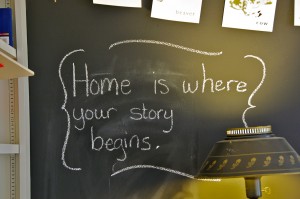 She and I had been discussing how different my sister and I are (I’ve always said that if we hadn’t been born sisters, we never would have met), and I said, “I could understand it better if she and I had been born further apart, but there’s only a year and a half separating us — we were raised by the same parents, at the same time in their lives.”
She and I had been discussing how different my sister and I are (I’ve always said that if we hadn’t been born sisters, we never would have met), and I said, “I could understand it better if she and I had been born further apart, but there’s only a year and a half separating us — we were raised by the same parents, at the same time in their lives.”
And then that’s when my mom shared some stories that rocked my brain.
When my mom was in high school, this would be the late 1950s, she wanted a summer job. Her father said he would recommend her to the diaper washing service next to his auto-body shop if she promised to work every single day — not miss one day, or ever be late. She agreed, he made the recommendation, and she got the summer job.
She went in to work every day, all summer long. Then one night, she and her boyfriend — her first love, broke up. She spent all night crying, as teenage girls will do. When she woke up and her father spotted her in the hall, he asked her why she wasn’t yet dressed for work. She responded that she was a mess, that she could barely see through her puffy eyes, that she wouldn’t be going into work that day. Her father looked directly at her, said, “You gave your word,” then turned on his heel and left.
Mom quickly got dressed and to work on time. She never missed one day of work and lived up to her word.
When it came time for her younger sister Vickie, mom’s junior by nine years, to get a summer job, Vickie only worked four days before she quit. Years later, when having some sister-chat, my Aunt Vicki asked her sister, my mother, “Why didn’t they teach me to be responsible, like they did you?”
My mom’s response was, “You came along at a different time in their lives; you were their baby and they had different expectations of you.”
That is probably a fair analysis. And an amazingly insightful, non-spiteful, response from my mother to boot.
But my mom wasn’t done sharing her stories.
A few years after the summer laundry job, my mom worked full-time as a secretary at a finance company. This was at the same time that her brother, Mike, just two years her junior, was working at Pabst. My mom was paying $15 a week in rent to her parents. She thought nothing of it until she discovered that her brother wasn’t paying anything to their parents.
When she asked her parents why she paid rent and her brother did not, the answer (given in that “you’re so silly to ask” tone of condescension) was that “she was working for pin money, but Mike was a man.”
Even though “Mike the man” wasn’t supporting a family (his paycheck went to purchase beer), the assumption was that he was working for a future, that his paycheck and job were more important. He was expected to work; she was not. The price for her frivolity in dabbling in employment was one she would have to pay for.
Even now when I think about this I am amazed. Not just that this greatly shifts my perception of my beloved grandparents, who were a product of their own times, but that my mother who was raised by and living with these people had the guts to question her parents about this gender bias.
But that’s not even the worst of it.
When I expressed my surprise and shock — including that I’d never heard these stories before, my mother shared one more…
This one is about my cousins, Lisa & Danny, who are my Uncle Mike’s kids.
Recently, my cousin Lisa was out to lunch with my mom and she confessed that both she and her brother felt they never pleased their father; Danny for not being a macho sports guy — and Lisa for not being a boy at all. It was so bad that Lisa said, “You know, my mom never read to me. Not once. She read to Danny.” And then she rapidly tacked on — as if risking being accused of being unfair or mean-spirited, “I could listen though.”
Images of a small shy child silently lurking in the doorway while a mother snuggled with a sibling on a bed, reading to him from a book he’d selected… *shudder*
I always wondered why my cousin Lisa was so shy — painfully so. Ill-confident, uncomfortable in her own skin. How can you be anything else when your own parents don’t think you’re worthy of being read to because you’re not a male child?
It sounds the stuff of the 1950s, not the 1960s and 70s… If “America” at all.
But here it is, gender bias bullshit, from real lives, not text book depictions; from my family, some of it even in my lifetime. It’s real. It’s still living here, if only in echos. And poor self esteem.
Image via Steady Mom.
For our brothers and sisters in Wisconsin, a historical reminder: Child at an auto strike in 1948. Have you signed up for Saturday’s solidarity rally in your area yet?
Photo via Vintage Gal.
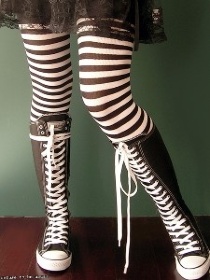
With the current state of affairs — i.e. republicans trying to defund Planned Parenthood, it seems these Knee High Converse shoes might become affordable birth control. (Yes, even at $60+ they are a one-time purchase.) Since, even with the zipper, it takes a good 15-20 minutes to get them on or off (my 14 year old timed herself and tells me so), greatly delaying the removal of the unfortunately popular skinny jeans, jeggings, etc. (which are so tight they must be completely removed), these shoes might just be as good as a chastity belt.
Image via.
PS These shoes come in more than just black; in case you’d like your birth control to match more of your wardrobe.
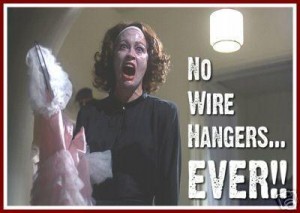 I’m invoking the name and memory of Joan Crawford to make a plea for those of you in the US to take action against those who would force women to face the wire hangers of the past.
I’m invoking the name and memory of Joan Crawford to make a plea for those of you in the US to take action against those who would force women to face the wire hangers of the past.
You must realize that the wealthy will always send their sisters, daughters, wives and girlfriends to other places for safe, legal abortions — even while they seek to deny the rest of us the rights to such “padded hangers.” So even if an abortion is against your morality, if it’s not a choice you could make, recognize the rights each of us has to make our own choices — safe choices which allow for the right to have future children, rather than render ourselves infertile (or worse) by seeking alternatives.
The women are already here, already have rights. Let each woman choose. If you believe it is against God’s will, then let him hand down the decree; you don’t get to play God in the name of preventing others from doing so.
Take action today.
Help Stop the “Stupak on Steroid” Agenda and Sign The Petition to stop the GOP war on women’s health.
I found this photo of a National Housewives League meeting Detroit, Michigan, in 1945 while researching the Organized Housewives, a completely unrelated group.
The National Housewives’ League of America was founded in the early part of the twentieth century to advance the economic status of African Americans. Its mission was to encourage African American housewives to patronize African American-owned businesses through “directed spending.”
The Rev. William H. Peck and his wife Fannie B. Peck, after hearing Alben L. Holsey of the National Negro Business League and Tuskegee Institute speak about the successes of the Colored Merchants Association and the New York Housewives’ Association, were inspired to create similar organizations in Detroit. Rev. Peck organized the Booker T. Washington Trade Association in April 1930. Mrs. Peck, believing that the support of those women who controlled most household budgets — housewives — was essential to any business success, founded the Housewives’ League of Detroit on June 10, 1930, with 50 members. In the next couple of years, Mrs. Peck went on to organize leagues in Cleveland, Cincinnati, and Toledo, Ohio; Indianapolis, Ind.; Pittsburgh, Pa.; Kansas City, Mo.; and Jacksonville, Fla. By 1932, Alben Holsey, impressed with the response of the women in the leagues, invited Mrs. Peck and the other league representatives to meet in New York City to form a national committee, which Mrs. Peck chaired. The following year, the national committee met in Durham, N.C., in concert with the National Negro Business League, and formally organized the National Housewives’ League of America, Inc. Mrs. Peck was elected the first president of the organization.
I find this notion of housewives, and the purchase power of women in general, quite incredible… Normally we only hear of the economic power of those who control most household budgets in terms of boycotts, not as positive actions and long term change-making acts too.
Some related facts on the economic powers of women, which I heartily suggest you use to best impact social and economic change along with your household budget:
From 2005 Wow! Quick Facts Book, published by United States Census Bureau:
* Women control 80 percent of household spending
* They make up 47 percent of investors
* Women buy 81 percent of all products and services
* They buy 75 percent of all over-the-counter medications
* They make 81 percent of all retail purchases
* Women buy 82 percent of all groceries
* Women sign 80 percent of all checks written in the United States
* They make up 40 percent of all business travelers
* They make 51 percent of all travel and consumer electronics purchases
* Women influence 85 percent of all automobile purchases
* They head up 40 percent of all U.S. households with incomes over $600,000
* They own 66 percent of all home-based businesses
* Women have been the majority of voters in the United States since 1964
For more information on the history of the Housewives League, see Housewives League of Detroit (HLD) and the records at Bentley Historical Library at the University of Michigan (where the images are from).
A vintage ad (Newsweek, 1950), in which those wise and merciful corporations, Electric Light & Power Companies, expose their virtues while exposing the menace that is government regulation, comparing it to snake oil. My fav line is one that Glenn Beck himself could have written or spit: “What they don’t realize is: when any government takes over enough things, socialism comes automatically.” I guess we all just need to tell government to back off and entrust our lives to corporations. Not.